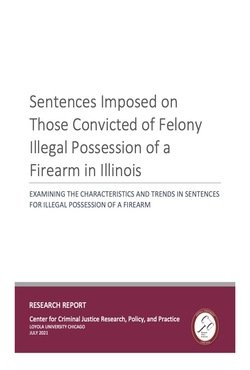Sentences Imposed on Those Convicted of Felony Illegal Possession of a Firearm in Illinois: Examining the Characteristics and Trends in Sentences for Illegal Possession of a Firearm
By David E. Olson, Don Stemen, Kaitlyn Foust, Cynthia Guzman, Lisa Jacobs, Sophia Juarez, Holly Michalak, Avery Pankratz, and Amanda Ward
Loyola University Chicago’s Center for Criminal Justice Research, Policy and Practice, through the support of the Joyce Foundation, completed the most comprehensive, detailed analysis of the sentencing of those convicted of firearm possession offenses in Illinois to date. These offenses do not involve the use of a firearm in the commission of a violent crime or the unlawful discharge of a firearm. Rather, these convictions are for the possession of a firearm by individuals not legally authorized to possess or carry a firearm because of their age, having a prior felony conviction, or not applying for and receiving a license to carry a concealed handgun. Depending on the factor(s) that make the possession of a firearm illegal, the legal classifications and possible sentences range from Class 4 felonies (the least serious felony) to Class X felonies (the most serious felonies other than first degree murder), and carry sentences ranging from probation for up to 30 months to 30 years in prison. Out of all the arrests and convictions in Illinois for firearm-related offenses over the past decade, 72% have been for firearm possession offenses while 28% have been for the use of a firearm in the commission of a violent crime or illegal discharge of a firearm. Despite the concern over firearm violence, and increasingly punitive laws surrounding illegal firearm possession offenses implemented over the past 15 years, the lack of objective, detailed research limits the ability of practitioners and policy makers to assess the efficacy and impact of these approaches.
Chicago: Loyola University Chicago, Center for Criminal Justice Research, Policy and Practice, 2021. 33p.


